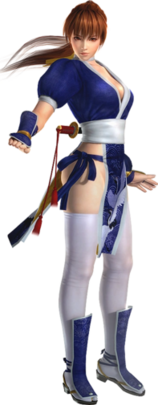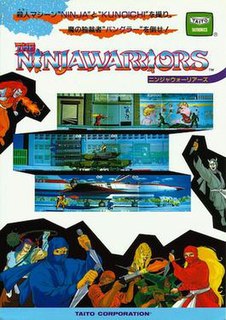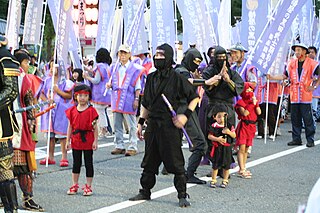| Look up kunoichi in Wiktionary, the free dictionary. |
A kunoichi is a female ninja.
Contents
Kunoichi may also refer to:
| Look up kunoichi in Wiktionary, the free dictionary. |
A kunoichi is a female ninja.
Kunoichi may also refer to:
Shinobi (忍び) is the Japanese word for male ninja. It may also refer to:

Kasumi is a fictional character and the protagonist of the Dead or Alive fighting game series by Team Ninja and Tecmo. Kasumi has served as the lead character of the Dead or Alive franchise since its premiere in 1996. She was a main character in the first and fifth games of the series and in the film DOA: Dead or Alive.

Yuffie Kisaragi is a video game character from Square Enix's Final Fantasy series. Designed by Tetsuya Nomura, she was first introduced in the 1997 role-playing video game Final Fantasy VII as a young female ninja princess and thief. She can become one of the game's player characters after finishing a special sidequest. Yuffie reappears in the Compilation of Final Fantasy VII series, expanding her background and showing her after the events of the original game.
Aeon or æon means age, or alternatively forever or for eternity. It may also refer to:
Ayane is a video game character in the Dead or Alive and Ninja Gaiden series by Team Ninja and Koei Tecmo. She debuted as a hidden character in the PlayStation version of the fighting game Dead or Alive in 1998, and has appeared in all of its sequels and spin-offs so far, including as the main protagonist of Dead or Alive 3. In the games, Ayane is a teenage master of ninjutsu and is characterised by her complex relationship with her half-sister Kasumi, the lead character of the Dead or Alive series.

The Ninja Warriors (ニンジャウォーリアーズ) is a side-scrolling beat 'em up developed and released by Taito in 1987. The original arcade game situated one display in between projected images of two other displays, creating the appearance of a triple-wide screen. Ports were released for the Amiga, Atari ST, ZX Spectrum, Commodore 64, Amstrad CPC, TurboGrafx-16, and Mega-CD.
A ninja was a secret agent or mercenary of feudal Japan specializing in unorthodox arts of war.

Ninjas are historically known as Japanese spies, assassins, or thieves who formed their own caste outside the usual feudal divisions of lords, and samurai serfs. They are often used as stock characters, in Japanese popular culture and global popular culture.

Blood Warrior, known in Japan as Ooedo Fight, is a 1993 fighting arcade game developed by Atop and published by Kaneko. It is the successor to the 1992 fighting arcade game, Shogun Warriors, also developed by Atop and published by Kaneko. Unlike Shogun Warriors, Blood Warrior uses digitized images of real actors within the game instead of traditionally drawn sprites, and its addition of blood and gore draws similarities to Midway's Mortal Kombat franchise.
A kunoichi is a female ninja or practitioner of ninjutsu (ninpo). During the feudal period of Japan, ninjas were used as killers, spies and messengers. The training of kunoichi differed from the training given to male ninjas, although they had a common core of skills, being trained in martial arts, such as taijutsu and ninjutsu. Kunoichi training tended to prioritize traditional female skills.
Many significant Japanese historical people of the Sengoku period appear in works of popular culture such as anime, manga, and video games. This article presents information on references to several historical people in such works.

Taki, known as the Hunter of Darkness, is a fictional character in the Soulcalibur series of historical fantasy fighting games by Namco. Taki is a Japanese demon-hunting kunoichi and the greatest warrior of the Fu-Ma ninja clan, who is traveling the world on a quest to destroy the powerful swords known as Soul Edge and Soul Calibur.
Kaede (楓) ("maple") may refer to:

The Ninja Warriors is a beat 'em up video game developed by Natsume for the Super Nintendo Entertainment System and published by Taito in Japan and North America in 1994 and by Titus in Europe in 1995. It is a follow-up to Taito's 1987 arcade game of the same title, and shares similar gameplay. The player can choose between playing as one of three ninja androids, each with different attributes and a unique set of moves including jumps, dashes, throws, and other attacks. The game was developed by the same team at Natsume that later developed Wild Guns (1994).
Ninja Warrior may refer to:

Senran Kagura is a video game series created by Kenichiro Takaki, produced by Marvelous and mostly developed by Tamsoft. The franchise revolves around groups of female shinobi, and has received manga and anime adaptations. The anime has been licensed by Funimation Entertainment in North America.

Momiji (紅葉) is a fictional character from the Ninja Gaiden series of video games by Team Ninja and Koei Tecmo. She is a ninja shrine maiden and an apprentice and team mate of the series' protagonist Ryu Hayabusa, who was introduced as a supporting playable character in 2008's action game Ninja Gaiden: Dragon Sword. Momiji later returned in this role in Ninja Gaiden Sigma 2 and Ninja Gaiden 3: Razor's Edge, and is also available in Dead or Alive 5 Ultimate/Last Round, Dead or Alive 6, Warriors Orochi 3 Hyper/Ultimate, and Dead or Alive Xtreme 3. She becomes the one of the two main protagonists of the upcoming Ninja Gaiden 4. In most of her appearances, Momiji is voiced by Yūko Minaguchi in Japanese and by Kate Higgins in English. Her character has been generally well received by the series' fans and game critics.

Hyrule Warriors is a hack and slash video game developed by Omega Force and Team Ninja for the Wii U video game console. The game is a collaboration between Koei Tecmo and Nintendo, mixing settings and characters from Nintendo's The Legend of Zelda with the gameplay of Koei's Dynasty Warriors series. Hyrule Warriors was released in Japan in August 2014, and worldwide the following month. It became one of the best-selling games on the Wii U. An updated port, Hyrule Warriors Legends, was released for the Nintendo 3DS in Japan in January 2016 and worldwide in March of the same year. A third enhanced port, Hyrule Warriors: Definitive Edition, was released for the Nintendo Switch in 2018. A successor, Hyrule Warriors: Age of Calamity, was released exclusively for the Nintendo Switch in November 2020.
Kagerō, also spelled Kagerou, is the Japanese word for "heat haze" (陽炎) or "mayfly", and may refer to:

Bikini Warriors is a Japanese media franchise. It primarily consists of a series of fantasy figures created by Hobby Japan and Megahouse, featuring character designs from multiple artists including Rei Hiroe, Hisasi, Saitom and Tony. A 12-episode anime television series based on the setting aired from July 7 to September 22, 2015. A manga series and a video game have also been announced.